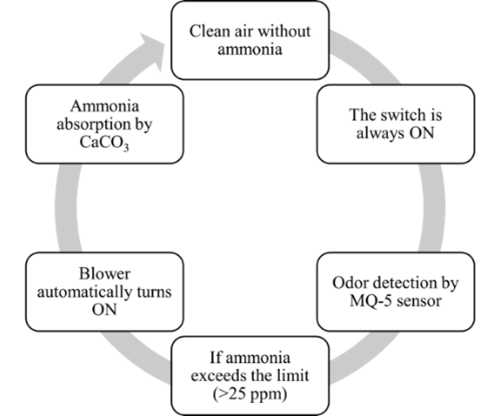Design of an exhaust fan with activated charcoal in a broiler closed houses for ammonia gas mitigation
DOI:
https://doi.org/10.55674/snrujst.v14i3.247352Keywords:
Activated charcoal, Exhaust fanAbstract
Currently, the broiler chicken coop has changed from an opened house system to a closed house system. The problem that arises with the closed house cage system is farmers only think about the health and productivity of broiler chickens in the cage, without thinking about the environmental impact caused by the ammonia gas released from the cage. It is necessary to modify the exhaust fan design with activated charcoal in closed house broilers to mitigate ammonia gas on the inside and outside of broiler chicken coop. Tools and materials used in designing the tool are Box Panel, Wireless Sensor Network, Chimney, Raspberry Pi + LCD, Activated Charcoal, MQ-5 sensor, Electric sensor & controller unit and PCB. The exhaust fans system with activated charcoal is able to absorb unpleasant odors in broiler closed houses. This tool system uses an absorbent principle that works to absorb ammonia using CaCO3 activated charcoal with an intensity of time of 14 – 16 minutes to reduce ammonia levels to 25 – 30 ppm.
References
Badan Pusat Statistik, https://www. bps. go.id/indicator/24/478/1/populasi-ayam-ras -pedaging-menurut-provinsi.html, 1 January 2022.
Kementerian Pertanian - Buku Statistik Peternakan dan Kesehatan Hewan Tahun 2021, http://ditjenpkh.pertanian.go.id/, 1 January 2022.
M.N. Arifin, Monitoring Kadar Gas Berbahaya pada Kandang Ayam dengan Meng gunakan Protokol HTTP dan ESP8266, J-PTIIK. 2(11) (2018) 4600 – 4606.
J. Brouček, B. Čermák, Emission of Harmful Gases from Poultry Farms and Possibilities of Their Reduction, Ekol. Bratisl. 34(1) (2015) 89 – 100.
M.D. Oliveira, F.C. Sousa, J.O. Saraz, A.A. Calderano, I.F.F. Tinôco, A.P.S. Carneiro, Ammonia Emission in Poultry Facilities: A Review for Tropical Climate Areas, Atmosphere. 12 (2021) 9 – 20.
B.P. Mahardhika, R. Mutia, M. Ridla, Effort to reduce ammonia gas in the broiler chicken excreta with the addition of probiotic as substitute for antibiotic growth promoter, IOP Conf. Ser.: Earth Environ. Sci. 883(1) (2021) 012013.
T. K. Dewi, A. Nurrahma, E. Permana, Pembuatan Karbon Aktif Dari Kulit Ubi Kayu (Mannihot Esculenta), Jurnal Teknik Kimia. 16(1) (2009) 24 – 30.
S. Jamilatun, M. Setyawan, Pembuatan Arang Aktif dari Tempurung Kelapa dan Aplikasinya untuk Penjernihan Asap Cair, SPEK IND. 12(1) (2014) 73 – 86.
E. Kurniati, Pemanfaatan Cangkang Kelapa Sawit sebagai Arang Aktif: Penelitian Ilmu Teknik, UPN Jatim. 8(2) (2008).
J. Murtono, Iriany, Pembuatan Karbon Aktif Dari Cangkang Buah Karet Dengan Aktivator H3PO¬4 dan Aplikasinya sebagai Penjerap Pb(II), JTK USU. 6(1) (2017) 43 – 48.
K.T. Basuki, Penurunan Konsentrasi CO dan NO pada Emisi Gas Buang dengan Menggunakan Media Penyisipan TiO2 Lokal Pada Karbon Aktif, JFN. 1(1) (2007) 1 – 9.
G. Busca, C. Pistarino, Abatement of ammonia and amines from waste gases: a summary, JLPPI. 2(16) (2003) 157 – 163.
S. Ketaren, Pengantar teknologi minyak dan lemak pangan, Edisi 1, Universitas Indonesia Press, Jakarta, 1986.
G. Pari, D. Tohir, M. Mahpudin, J. Ferry, Arang Aktif Serbuk Gergaji Kayu sebagai Bahan Adsorben pada Pemurnian Minyak Goreng Bekas, JPHK. 24(4) (2006) 309 – 322.
C.E. Gokce, S. Guneysu, S. Aydin, S. Arayici, Comparison of Activated Carbon and Pyrolyzed Biomass for Removal of Humic Acid from Aqueous Solution, TOEPTJ. 1(1) (2009) 43 – 48.

Downloads
Published
How to Cite
Issue
Section
License
Copyright (c) 2022 SNRU Journal of Science and Technology

This work is licensed under a Creative Commons Attribution-NonCommercial-NoDerivatives 4.0 International License.








